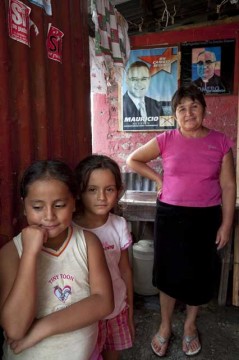2009 was marked by two symbolically significant changes in government in the American hemisphere. The first African American, Barack Obama, was sworn in as President of the United States, a potent symbol of tangible progress for those who struggled against racial injustice during the civil rights movement of the 1960s. In El Salvador, Mauricio Funes was the first candidate from the leftist FMLN (Farabundo Martí Front for National Liberation) to be elected to lead the nation. There was also symbolism here as the political party formed by former insurgents after the 1992 peace accords finally achieved the confidence of a majority of the Salvadoran electorate.

In historic elections Salvadorans vote for the first FMLN president Maurico Funes. They hope that his government can restore community trust as well as alleviating poverty and reducing crime.
For El Salvador the economic relationship with the US is critical. The small nation of 7 million uses US currency as it own. It exports 10 percent of its Gross Domestic Product to the US and receives another 18% of its revenue in the form of remittances from Salvadorans living and working in the United States. The combination of these factors makes El Salvador very vulnerable to the impact of the US economic recession as well as political pressures.
Some among the Obama administration’s highest level advisors on Latin America would have preferred the re-election of the right wing ARENA party. But the administration’s stance of neutrality in the days before the election and expression of support for President Funes may reveal a new direction for US Latin American relations.
Each election marked a triumph of hope and change against a politics based upon themes of fear and security. However both administrations face tough leadership challenges with their own highly polarized domestic political landscapes as well as a somewhat wary responses to meanings of the other’s symbolism.